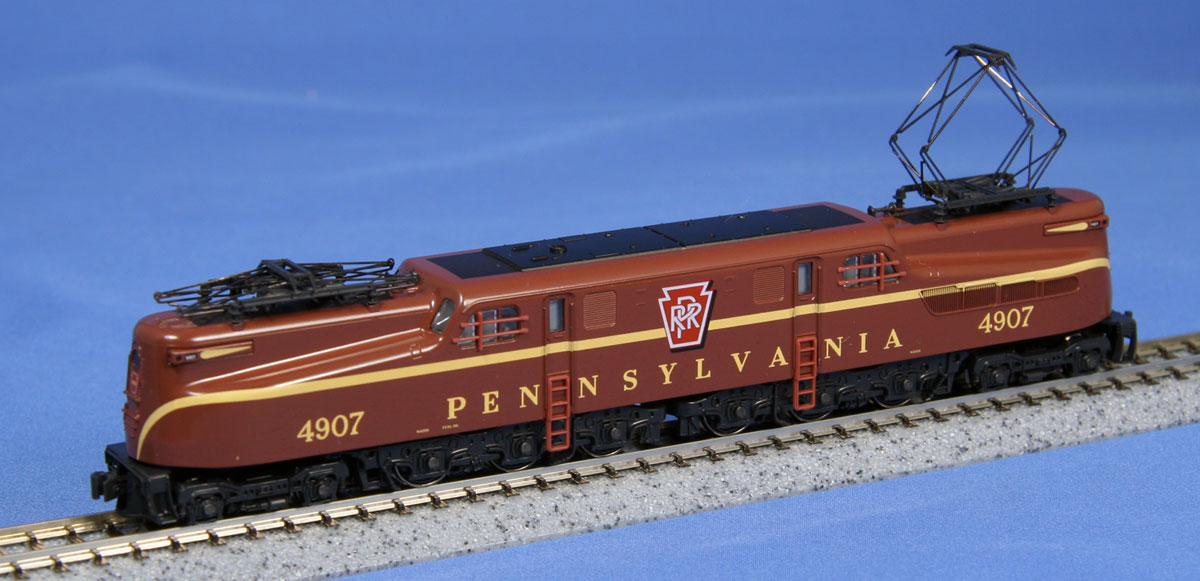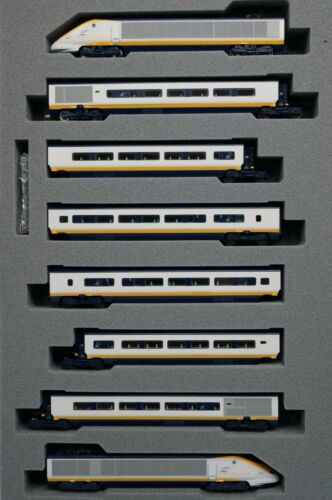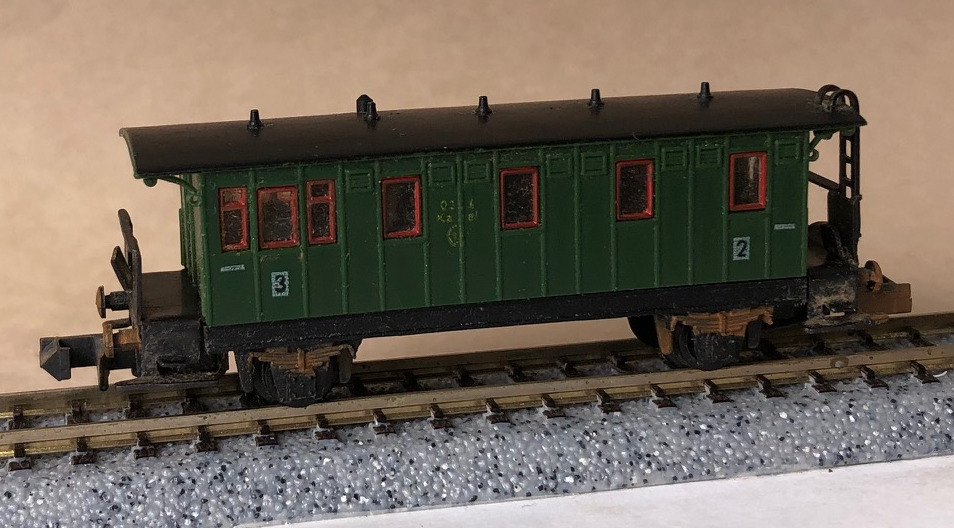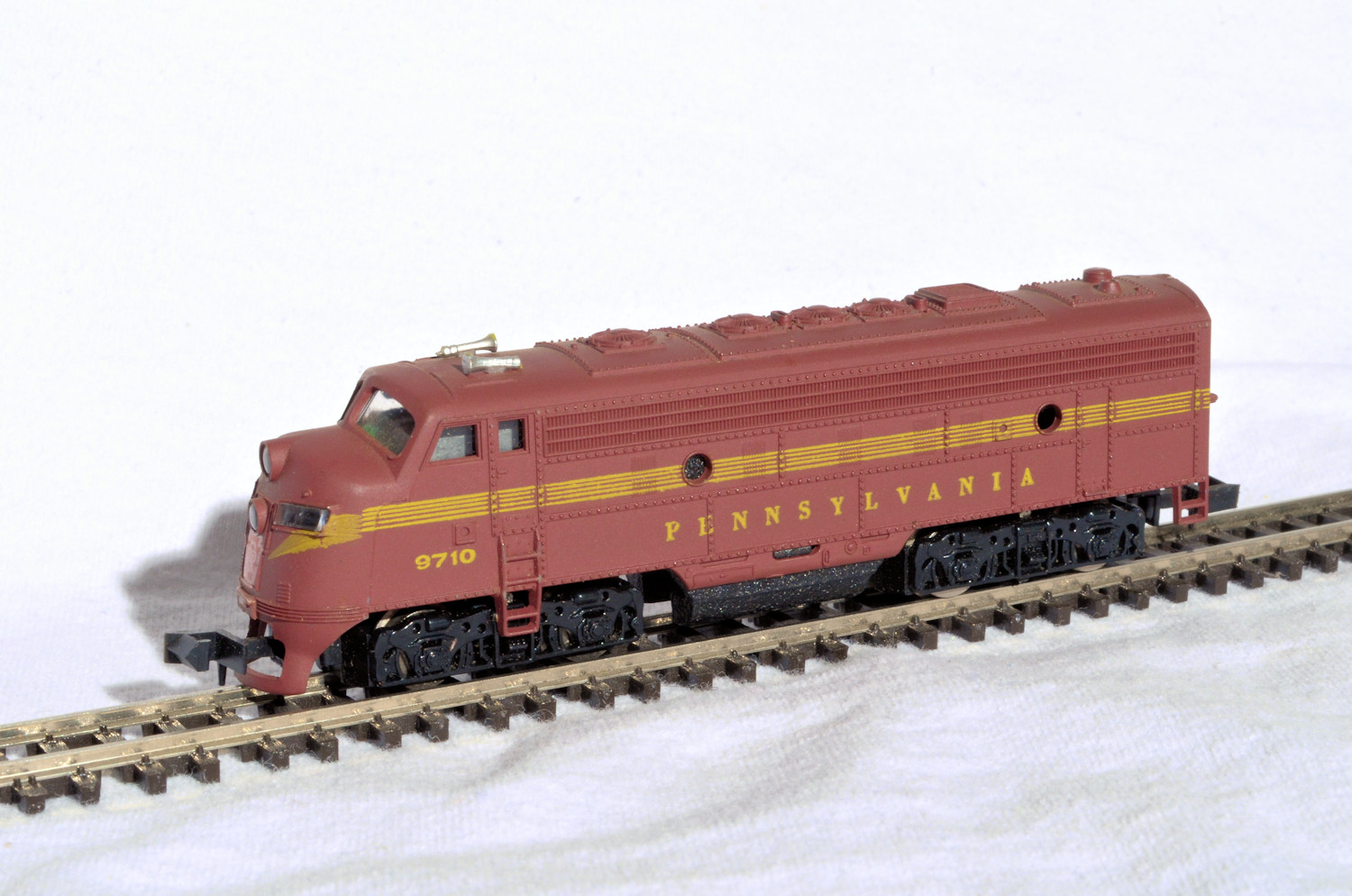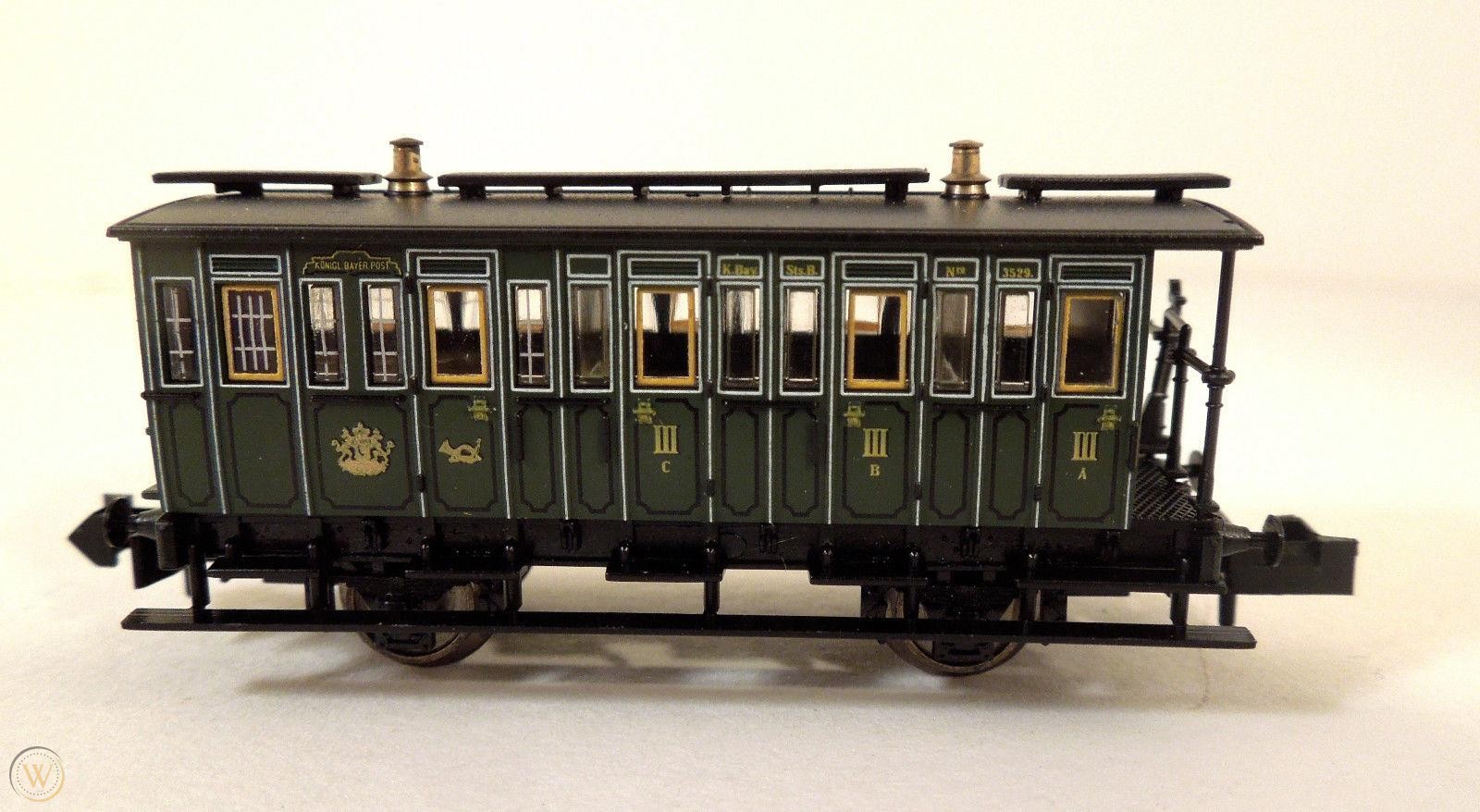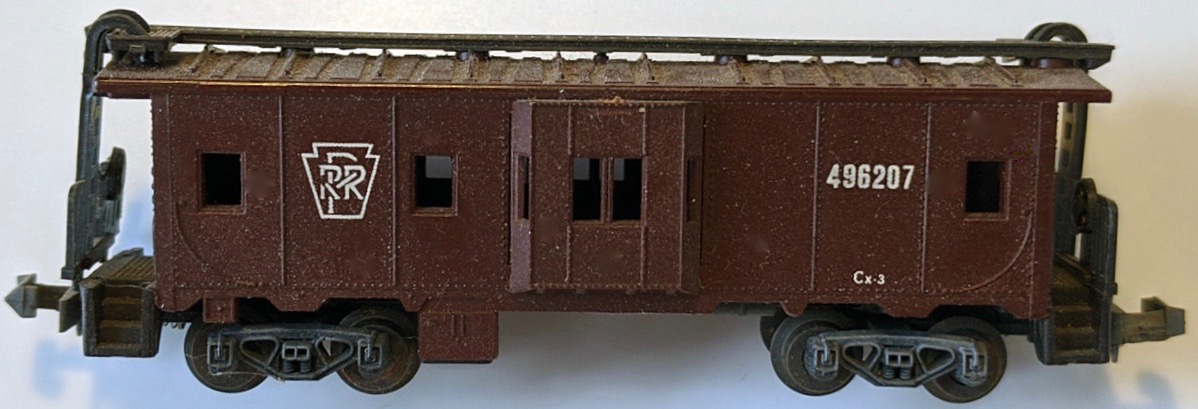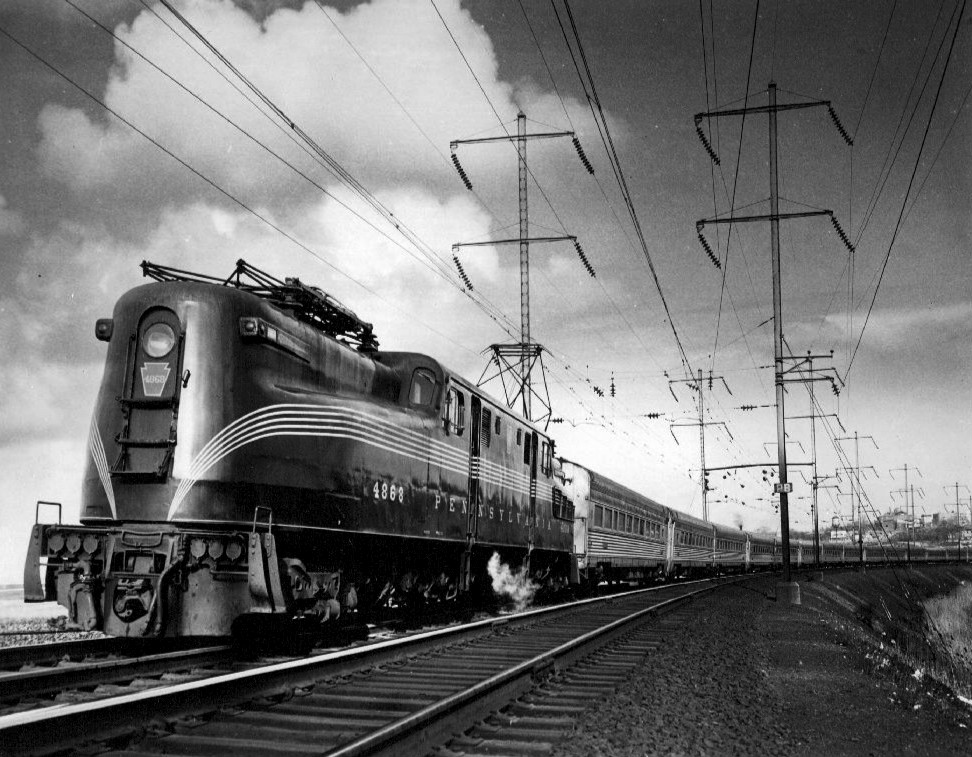Model Information: This model was introduced in 2008. This Kato engine features all standard features of a post-2000 design. These include a split-frame chassis, low-profile chemically blackened wheels, dual flywheels, magnetically operating couplers and the ability to drop in a DCC decoder. It also uses the "shock-absorber" suspension system for the top section of the chassis.
The modern design, enhanced by the "shock-absorber" leads to superb performance and quiet running. It will pull 40+ cars on a flat grade. The prototype is amazing looking and this model does it justice. It is flat-out cool looking. Sadly, the pantagraphs do not conduct and are not spring-loaded, but they are metal (unlike the ACS-64 model) and they are hinged so they can be moved up or down. Despite the gi-normous trucks, they do run nicely over tight 9 3/4" curves.
The modern design, enhanced by the "shock-absorber" leads to superb performance and quiet running. It will pull 40+ cars on a flat grade. The prototype is amazing looking and this model does it justice. It is flat-out cool looking. Sadly, the pantagraphs do not conduct and are not spring-loaded, but they are metal (unlike the ACS-64 model) and they are hinged so they can be moved up or down. Despite the gi-normous trucks, they do run nicely over tight 9 3/4" curves.
DCC Information: This model accepts a Digitrax DN163K1D1 decoder
Prototype History: The PRR GG1 was a class of electric locomotives built for the Pennsylvania Railroad (PRR) for use in the northeastern United States. Between 1934 and 1943, General Electric and the PRR's Altoona Works built 139 GG1s. The GG1 entered service with the PRR in 1935, and later operated on successor railroads Penn Central, Conrail and Amtrak. The last GG1 was retired by New Jersey Transit in 1983. Most have been scrapped, but several remain in museums.
The mechanical design of the GG1 was based largely on the New Haven EP3, which had been borrowed earlier from the New Haven Railroad by the PRR to compare it to its current standard electric locomotive, the P5a. In 1933, the PRR decided to replace its P5a locomotives and told General Electric and Westinghouse to design prototype locomotives with the following specifications: a lighter axle load and more power than the P5a, a top speed of at least 100 miles per hour (160 km/h), a streamlined body design and a single (central) control cab.
Both companies delivered their prototypes to PRR in August 1934. General Electric submitted the GG1 and Westinghouse submitted the R1. The R1 was essentially "little more than an elongated and more powerful version of the P5a" with an AAR wheel arrangement of 2-D-2. Both locomotives were tested for ten weeks in regular service between New York and Philadelphia and on a test track in Claymont, Delaware. Because the R1's rigid wheelbase prevented it from negotiating sharp curves and some railroad switches, PRR chose the GG1 and ordered 57 additional locomotives on November 10, 1934. Of the 57, 14 were to be built by General Electric in Erie and 18 at the Altoona Works. The remaining 20 locomotives were to be assembled in Altoona with electrical components from Westinghouse in East Pittsburgh and chassis from the Baldwin Locomotive Works in Eddystone. An additional 81 locomotives were then built at Altoona between 1937 and 1943.
On January 28, 1935, to mark the completion of the electric line from Washington, D.C to New York City, PRR ran a special train pulled by PRR 4800 before it opened the line for revenue service on February 10. It made a round trip from D.C. to Philadelphia and, on its return trip, set a speed record by arriving back in D.C. 1 hour and 50 minutes after its departure from Philadelphia.
In the mid-1950s, with declining demand for passenger train service, GG1s 4801?4857 were re-geared for a maximum speed of 90 miles per hour (140 km/h) and placed in freight service. They initially retained their train heating steam generator, and were recalled to passenger service for holiday season mail trains, and 'Passenger Extras' such as those run for the annual Army?Navy football game in Philadelphia.
Timetable speed limit for the GG1 was 75-80 mph until October 1967 when some were allowed 100 mph for a year or two;[citation needed] when Metroliner cars were being overhauled in the late 1970s, GG1s were again allowed 100 mph when pulling Amfleet cars on trains scheduled to run 224.6 miles from New York to Washington in 3 hours 20?25 minutes.
The first designer for the GG1 project was industrial designer Donald Roscoe Dohner, who produced initial scale styling models, although the completed prototype looked somewhat different.[13][14] At some point, PRR hired famed industrial designer Raymond Loewy to "enhance the GG1's aesthetics."
From Wikipedia
The mechanical design of the GG1 was based largely on the New Haven EP3, which had been borrowed earlier from the New Haven Railroad by the PRR to compare it to its current standard electric locomotive, the P5a. In 1933, the PRR decided to replace its P5a locomotives and told General Electric and Westinghouse to design prototype locomotives with the following specifications: a lighter axle load and more power than the P5a, a top speed of at least 100 miles per hour (160 km/h), a streamlined body design and a single (central) control cab.
Both companies delivered their prototypes to PRR in August 1934. General Electric submitted the GG1 and Westinghouse submitted the R1. The R1 was essentially "little more than an elongated and more powerful version of the P5a" with an AAR wheel arrangement of 2-D-2. Both locomotives were tested for ten weeks in regular service between New York and Philadelphia and on a test track in Claymont, Delaware. Because the R1's rigid wheelbase prevented it from negotiating sharp curves and some railroad switches, PRR chose the GG1 and ordered 57 additional locomotives on November 10, 1934. Of the 57, 14 were to be built by General Electric in Erie and 18 at the Altoona Works. The remaining 20 locomotives were to be assembled in Altoona with electrical components from Westinghouse in East Pittsburgh and chassis from the Baldwin Locomotive Works in Eddystone. An additional 81 locomotives were then built at Altoona between 1937 and 1943.
On January 28, 1935, to mark the completion of the electric line from Washington, D.C to New York City, PRR ran a special train pulled by PRR 4800 before it opened the line for revenue service on February 10. It made a round trip from D.C. to Philadelphia and, on its return trip, set a speed record by arriving back in D.C. 1 hour and 50 minutes after its departure from Philadelphia.
In the mid-1950s, with declining demand for passenger train service, GG1s 4801?4857 were re-geared for a maximum speed of 90 miles per hour (140 km/h) and placed in freight service. They initially retained their train heating steam generator, and were recalled to passenger service for holiday season mail trains, and 'Passenger Extras' such as those run for the annual Army?Navy football game in Philadelphia.
Timetable speed limit for the GG1 was 75-80 mph until October 1967 when some were allowed 100 mph for a year or two;[citation needed] when Metroliner cars were being overhauled in the late 1970s, GG1s were again allowed 100 mph when pulling Amfleet cars on trains scheduled to run 224.6 miles from New York to Washington in 3 hours 20?25 minutes.
The first designer for the GG1 project was industrial designer Donald Roscoe Dohner, who produced initial scale styling models, although the completed prototype looked somewhat different.[13][14] At some point, PRR hired famed industrial designer Raymond Loewy to "enhance the GG1's aesthetics."
From Wikipedia
Road Name History: The Pennsylvania Railroad (reporting mark PRR) was an American Class I railroad, founded in 1846. Commonly referred to as the "Pennsy," the PRR was headquartered in Philadelphia, Pennsylvania.
The PRR was the largest railroad by traffic and revenue in the U.S. for the first half of the twentieth century. Over the years, it acquired, merged with or owned part of at least 800 other rail lines and companies. At the end of 1925, it operated 10,515 miles of rail line; in the 1920s, it carried nearly three times the traffic as other railroads of comparable length, such as the Union Pacific or Atchison, Topeka & Santa Fe railroads. Its only formidable rival was the New York Central (NYC), which carried around three-quarters of PRR's ton-miles.
At one time, the PRR was the largest publicly traded corporation in the world, with a budget larger than that of the U.S. government and a workforce of about 250,000 people. The corporation still holds the record for the longest continuous dividend history: it paid out annual dividends to shareholders for more than 100 years in a row.
In 1968, PRR merged with rival NYC to form the Penn Central Transportation Company, which filed for bankruptcy within two years. The viable parts were transferred in 1976 to Conrail, which was itself broken up in 1999, with 58 percent of the system going to the Norfolk Southern Railway (NS), including nearly all of the former PRR. Amtrak received the electrified segment east of Harrisburg.
The PRR was the largest railroad by traffic and revenue in the U.S. for the first half of the twentieth century. Over the years, it acquired, merged with or owned part of at least 800 other rail lines and companies. At the end of 1925, it operated 10,515 miles of rail line; in the 1920s, it carried nearly three times the traffic as other railroads of comparable length, such as the Union Pacific or Atchison, Topeka & Santa Fe railroads. Its only formidable rival was the New York Central (NYC), which carried around three-quarters of PRR's ton-miles.
At one time, the PRR was the largest publicly traded corporation in the world, with a budget larger than that of the U.S. government and a workforce of about 250,000 people. The corporation still holds the record for the longest continuous dividend history: it paid out annual dividends to shareholders for more than 100 years in a row.
In 1968, PRR merged with rival NYC to form the Penn Central Transportation Company, which filed for bankruptcy within two years. The viable parts were transferred in 1976 to Conrail, which was itself broken up in 1999, with 58 percent of the system going to the Norfolk Southern Railway (NS), including nearly all of the former PRR. Amtrak received the electrified segment east of Harrisburg.
Brand/Importer Information: KATO U.S.A. was established in 1986, with the first U.S. locomotive model (the GP38-2, in N-Scale) released in 1987. Since that time, KATO has come to be known as one of the leading manufacturers of precision railroad products for the modeling community. KATO's parent company, Sekisui Kinzoku Co., Ltd., is headquartered in Tokyo, Japan.
In addition to producing ready-to-run HO and N scale models that are universally hailed for their high level of detail, craftsmanship and operation, KATO also manufactures UNITRACK. UNITRACK is the finest rail & roadbed modular track system available to modelers today. With the track and roadbed integrated into a single piece, UNITRACK features a nickel-silver rail and a realistic-looking roadbed. Patented UNIJOINERS allow sections to be snapped together quickly and securely, time after time if necessary.
The Kato U.S.A. office and warehouse facility is located in Schaumburg, Illinois, approximately 30 miles northwest of Chicago. All research & development of new North American products is performed here, in addition to the sales and distribution of merchandise to a vast network of wholesale representatives and retail dealers. Models requiring service sent in by hobbyists are usually attended to at this location as well. The manufacturing of all KATO products is performed in Japan.
Supporters of KATO should note that there is currently no showroom or operating exhibit of models at the Schaumburg facility. Furthermore, model parts are the only merchandise sold directly to consumers. (Please view the Parts Catalog of this website for more specific information.)
In addition to producing ready-to-run HO and N scale models that are universally hailed for their high level of detail, craftsmanship and operation, KATO also manufactures UNITRACK. UNITRACK is the finest rail & roadbed modular track system available to modelers today. With the track and roadbed integrated into a single piece, UNITRACK features a nickel-silver rail and a realistic-looking roadbed. Patented UNIJOINERS allow sections to be snapped together quickly and securely, time after time if necessary.
The Kato U.S.A. office and warehouse facility is located in Schaumburg, Illinois, approximately 30 miles northwest of Chicago. All research & development of new North American products is performed here, in addition to the sales and distribution of merchandise to a vast network of wholesale representatives and retail dealers. Models requiring service sent in by hobbyists are usually attended to at this location as well. The manufacturing of all KATO products is performed in Japan.
Supporters of KATO should note that there is currently no showroom or operating exhibit of models at the Schaumburg facility. Furthermore, model parts are the only merchandise sold directly to consumers. (Please view the Parts Catalog of this website for more specific information.)
Item created by: gdm on 2015-11-11 09:27:40. Last edited by gdm on 2018-01-29 21:36:40
If you see errors or missing data in this entry, please feel free to log in and edit it. Anyone with a Gmail account can log in instantly.
If you see errors or missing data in this entry, please feel free to log in and edit it. Anyone with a Gmail account can log in instantly.


